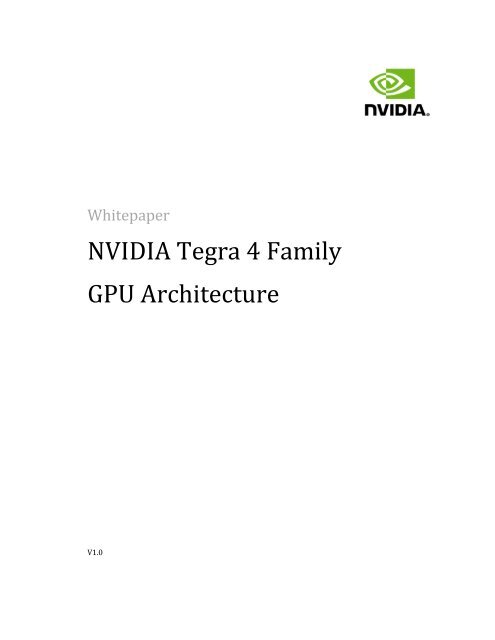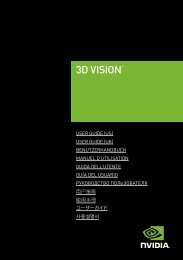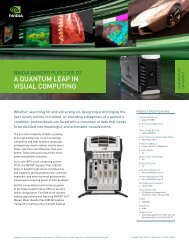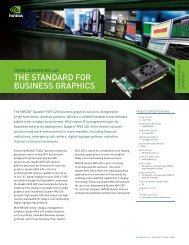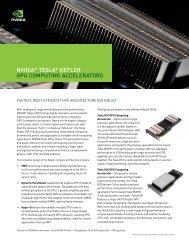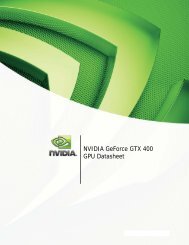Tegra 4 Whitepaper - Nvidia
Tegra 4 Whitepaper - Nvidia
Tegra 4 Whitepaper - Nvidia
- No tags were found...
Create successful ePaper yourself
Turn your PDF publications into a flip-book with our unique Google optimized e-Paper software.
<strong>Whitepaper</strong>NVIDIA <strong>Tegra</strong> 4 FamilyGPU ArchitectureV1.0
P a g e | 2Table of Contents...................................................................................................................................................................... 1Introduction .................................................................................................................................................. 3The Need for Fast Mobile GPUs .................................................................................................................... 3<strong>Tegra</strong> 4 Family GPU Features and Architecture ............................................................................................ 4<strong>Tegra</strong> 4 Family GPU Logical Pipeline Flow ................................................................................................ 5GPU Pipeline Implementation Details ...................................................................................................... 7Vertex Processing Engines .................................................................................................................... 7Raster Engine and Early-Z ..................................................................................................................... 8VLIW Pixel Fragment Shader Pipelines ................................................................................................. 8Texture Filtering Units........................................................................................................................... 9Additional GPU Features ..................................................................................................................... 10<strong>Tegra</strong> 4 and <strong>Tegra</strong> 4i vs <strong>Tegra</strong> 3 Comparative Peformance Factors .................................................... 12<strong>Tegra</strong> 4i GPU Architecture Diagram .................................................................................................... 13Architectural Efficiency ............................................................................................................................... 14Comparative Benchmark Performance ....................................................................................................... 16Advanced Power Management .................................................................................................................. 16<strong>Tegra</strong> GPU / Memory Controller Interface ................................................................................................. 17Enabling Advanced Graphics Effects in Mobile Games............................................................................... 19Developer Support .................................................................................................................................. 22Conclusion ................................................................................................................................................... 23Appendix A: <strong>Tegra</strong> 4 GPU Benchmarks ....................................................................................................... 24Appendix B: <strong>Tegra</strong> 4 / 4i Supported Video and Audio Formats .................................................................. 24Document Revision History ......................................................................................................................... 25NVIDIA <strong>Tegra</strong> 4 GPU Architecture February 2013
P a g e | 3IntroductionMobile devices are quickly becoming our most valuable personal computers. Whether we’rereading email, surfing the Web, interacting on social networks, taking pictures, playing games,or using countless apps, our smartphones and tablets are becoming indispensable. Manypeople are also using mobile devices such as Microsoft’s Surface RT and Lenovo’s Yoga 11because of their versatile form-factors, ability to run business apps, physical keyboards, andoutstanding battery life.Amazing new visual computing experiences are possible on mobile devices thanks to ever morepowerful GPU subsystems. A fast GPU allows rich and fluid 2D or 3D user interfaces, highresolution display output, speedy Web page rendering, accelerated photo and video editing, andmore realistic 3D gaming. Powerful GPUs are also becoming essential for auto infotainmentapplications, such as highly detailed and easy to read 3D navigation systems and digitalinstrument clusters, or rear-seat entertainment and driver assistance systems.Each new generation of NVIDIA ® <strong>Tegra</strong> ® mobile processors has delivered significantly higherCPU and GPU performance while improving its architectural and power efficiency. <strong>Tegra</strong>processors have enabled amazing new mobile computing experiences in smartphones andtablets, such as full-featured Web browsing, console class gaming, fast UI and multitaskingresponsiveness, and Blu-ray quality video playback.At CES 2013, NVIDIA announced <strong>Tegra</strong> 4 processor, the world’s first quad-core SoC using fourARM Cortex-A15 CPUs, a Battery Saver Cortex A15 core, and a 72-core NVIDIA GPU. With itsincreased number of GPU cores, faster clocks, and architectural efficiency improvements, the<strong>Tegra</strong> 4 processor’s GPU delivers approximately 20x the GPU horsepower of <strong>Tegra</strong> 2processor. The <strong>Tegra</strong> 4 processor also combines its CPUs, GPU, and ISP to create aComputational Photography Engine for near-real-time HDR still frame photo and 1080p 30video capture. Please see our whitepaper titled NVIDIA <strong>Tegra</strong> 4 Computational PhotographyArchitecture (Chimera) for more details.Another version of <strong>Tegra</strong> 4 processor called <strong>Tegra</strong> 4i processor (codenamed Project Grey) wasannounced in February 2013. <strong>Tegra</strong> 4i processor is the highest performing single-chipsmartphone processor in its class and integrates an NVIDIA i500 LTE modem and QuadCortex-A9 r4 cores, plus a 60-core GPU. We’ll provide more details of the <strong>Tegra</strong> 4i GPU in the<strong>Tegra</strong> 4 Family GPU Features and Architecture section.The Need for Fast Mobile GPUsOne of the most popular application categories that demands fast GPU processing is 3Dgames. Mobile 3D games have evolved from simple 2D visuals to now rival console gamingexperiences and graphics quality. In fact, some games that take full advantage of <strong>Tegra</strong> 4’sGPU and CPU cores are hard to distinguish graphically from PC games! Not only have themobile games evolved, but mobile gaming as an application segment is one of the fastestNVIDIA <strong>Tegra</strong> 4 GPU Architecture February 2013
P a g e | 4growing in the industry today. Visually rich PC and console games such as Max Payne andGrand Theft Auto III are now available on mobile devices.High quality, high resolution retina displays (with resolutions high enough that the human eyecannot discern individual pixels at normal viewing distances) are now being used in variousmobile devices. Such high resolution displays require fast GPUs to deliver smooth UIinteractions, fast Web page rendering, snappy high-res photo manipulation, and of course highquality 3D gaming. Similarly, connecting a smartphone or tablet to an external high-resolution4K screen absolutely requires a powerful GPU.With two decades of GPU industry leadership, the mobile GPU in the NVIDIA ® <strong>Tegra</strong> ® 4 Familyof mobile processors is architected to deliver the performance demanded by console-classmobile games, modern user interfaces, and high-resolution displays, while reducing powerconsumption to fall within mobile power budgets. You will see that the <strong>Tegra</strong> 4 processor is alsothe most architecturally efficient GPU subsystem in any mobile SoC today. Next, we’ll take adetailed look at the high performance GPU implemented in the <strong>Tegra</strong> 4 processor.<strong>Tegra</strong> 4 Family GPU Features and ArchitectureThe <strong>Tegra</strong> 4 processor’s GPU accelerates both 2D and 3D rendering. Although 2D rendering isoften considered a “given” nowadays, it’s critically important to the user experience. The 2Dengine of the <strong>Tegra</strong> 4 processor’s GPU provides all the relevant low-level 2D compositionfunctionality, including alpha-blending, line drawing, video scaling, BitBLT, color spaceconversion, and screen rotations. Working in concert with the display subsystem and videodecoder units, the GPU also helps support 4K video output to high-end 4K video display.The 3D engine is fully programmable, and includes high-performance geometry and pixelprocessing capability enabling advanced 3D user interfaces and console-quality gamingexperiences. The GPU also accelerates Flash processing in Web pages and GPGPU (GeneralPurpose GPU) computing, as used in NVIDIA’s new Computational Photography Engine,NVIDIA Chimera architecture, that implements near-real-time HDR photo and videophotography, HDR Panoramic image processing, and “Tap-to-Track” objecting tracking.As shown in the <strong>Tegra</strong> 4 family diagram in Figure 1 below, <strong>Tegra</strong> 4 processor includes a 72core GPU subsystem. The <strong>Tegra</strong> 4’s processor’s GPU has 6x the number of shader processingcores of <strong>Tegra</strong> 3 processor, which translates to roughly 3-4x delivered game performance andsometimes even higher. The NVIDIA <strong>Tegra</strong> 4i processor uses the same GPU architecture asthe <strong>Tegra</strong> 4 processor, but a 60 core variant instead of 72 cores. Even at 60 cores it delivers anastounding amount of graphics performance for mainstream smartphone devices.NVIDIA <strong>Tegra</strong> 4 GPU Architecture February 2013
P a g e | 5Figure 1 NVIDIA <strong>Tegra</strong> 4 Family Architecture<strong>Tegra</strong> 4 Family GPU Logical Pipeline FlowThe NVIDIA ® <strong>Tegra</strong> 4 ® and <strong>Tegra</strong> 4i processor’s GPUs implement an immediate-mode pipelinedesign tuned for high-performance and excellent power efficiency. Throughout the next fewsections, we’ll refer to the <strong>Tegra</strong> 4 processor, but the same logical pipeline details apply to the<strong>Tegra</strong> 4i processor. Reducing off-chip memory accesses is critical to power efficiency and highperformance in mobile SoC processors. The <strong>Tegra</strong> 4 processor’s GPU includes on-chip vertex,texture, and pixels caches to reduce off-chip memory accesses, and provide high hit rates whenservicing data requests. Early Z-culling logic helps ensure non-visible pixel fragments arediscarded before the pixel shading stage to avoid unnecessary shading work.In Figure 2 you can see the block called “OpenGL API calls” that feeds the Primitive Processingblock. Application-level API calls are interpreted by the graphics driver and the driver sendsvarious commands and pointers to vertex and texture data to the GPU. Vertex buffers arefetched and cached in a VBO Cache for subsequent reuse. Vertex shader programs execute inthe Vertex Shader units (also called Vertex Shader Pipeline or Vertex Processing Engine(VPE)), performing operations such as transforms and deformations on character and objectgeometry. The Primitives Assembly stage combines vertices to assemble primitives such aslines and triangles, and any primitives that reside outside of the camera’s viewing area(frustum), or are back-facing, are culled (removed) from the pipeline, and those that arecontained both inside and outside the viewing frustum have their outside portions clipped,NVIDIA <strong>Tegra</strong> 4 GPU Architecture February 2013
P a g e | 6because they should not be rendered. Edge and plane equations are calculated on theprimitives in preparation for rasterizing.Figure 2 – <strong>Tegra</strong> 4 Logical Graphics Processing PipelineThe Rasterizer converts primitives to pixels fragments to feed the pixel shader pipelines, andthe Early-Z unit can reject pixels that have depth (Z) values that would place them behind pixelsalready in the framebuffer. Pixel Shader pipes then operate on pixel fragments that pass the Z-test by running pixel shader programs on each pixel fragment. A programmable blend stage isincorporated in the Pixel Shader allowing any type of blend mode to be implemented, not onlythose found in the OpenGL spec.The Pixel Cache (also called the Fragment Data Cache) caches writes to the framebuffer and isuseful in reducing off-chip framebuffer traffic for user interface pixels or other areas that havehigh reuse, in addition to Early-Z testing.The texture unit fetches and filters texture data to apply to a pixel, and frequently accessedtexture data is cached in both L1 texture caches present in each Texture Unit and in a sharedL2 texture cache that is shared by all four texture units. Finally, the processed pixels can beNVIDIA <strong>Tegra</strong> 4 GPU Architecture February 2013
P a g e | 7blended with existing framebuffer pixel information, or they can overwrite the current framebufferpixel data.GPU Pipeline Implementation DetailsWe will discuss the NVIDIA ® <strong>Tegra</strong> ® 4 processor’s GPU physical pipeline below and refer to<strong>Tegra</strong> 4 processor, but many of the general descriptions, aside from unit counts, apply to the<strong>Tegra</strong> 4i processor as well. The <strong>Tegra</strong> 4 processor’s GPU Architecture Diagram below (Figure3) presents more details on the actual physical implementation of the <strong>Tegra</strong> 4 processor’s GPUsubsystem.Starting from the top, rendering commands are fetched through Host/Front End units (notshown). Next, indices and vertices are fetched directly from memory and cached by the IDXunit. IDX then passes vertices to multiple Vertex Processing Engines (VPEs). The IDX unit alsosupports DX9-level instancing, where a single draw command can make multiple instances of amodel, with each model using a different set of per-instance data.Figure 3 – <strong>Tegra</strong> 4 GPU Architecture DiagramVertex Processing EnginesVertices are processed by six VPE units in the <strong>Tegra</strong> 4 processor’s GPU, each including aVEC4 ALU (arithmetic logic unit) that contains four MAD (Multiply-Add) units (where MAD unitsare more commonly known as Vertex Cores). <strong>Tegra</strong> 4 processor includes a total of 24 vertexcores which is 6x the number of vertex cores in the <strong>Tegra</strong> 3 processor. A 96-entry Vertex BufferNVIDIA <strong>Tegra</strong> 4 GPU Architecture February 2013
P a g e | 8Object cache, split 16KB per VPE, allows vertex reuse and reduces off-chip memory accesses.Architectural improvements have resulted in a performance increase of up to 1.5x over NVIDIA ®<strong>Tegra</strong> ® 3 processor per vertex pipe when running at the same clock. The vertex shader coresuse FP32 precision for their computation to ensure geometric accuracy.As described in the Logical Pipeline section, primitives are assembled from the vertices, andany primitives that aren’t visible or back-facing are culled, or if they extend beyond the viewfrustum they are clipped. Edge and plane equations are calculated on the primitives inpreparation for rasterizing.Raster Engine and Early-ZThe Raster Engine generates pixel fragments from the primitives and can provide eight pixelfragments per clock to the Pixel Shader pipes, similar to the <strong>Tegra</strong> 3 processor. Both the <strong>Tegra</strong>4 processor and the <strong>Tegra</strong> 4i processor now support 2x and 4x Multisample Antialiasing(MSAA), 24-bit Z, and 8-bit Stencil processing. The Raster Unit generates pixel fragments(samples when MSAA is enabled) with associated 24-bit Z and 8-bit stencil values.The Early-Z unit works in concert with the Raster Unit and is an optimized version of theimplementation used in high end desktop GeForce GPUs. The Early-Z operation tests all thepixels or samples for Z-depth, and only passes on pixels or samples that are visible. Byperforming an Early-Z test and discarding hidden pixels, much wasted work fetching Z, color,and texture data for hidden pixels is avoided, in addition to avoiding much unnecessary pixelcomputation in the Pixel Shader pipes. Early-Z is able to detect and discard hidden pixels at arate of eight pixels/clock (8ppc).Early-Z processing delivers improved performance and power savings by reducing memorytraffic between the GPU and off-chip memory. In rare situations, the programmer may requirecertain pixels to be hidden until pixel processing is complete. For these cases, a late-stagedepth test occurs within the pixel shader and blend units.VLIW Pixel Fragment Shader PipelinesEach of the four Pixel Fragment Shader pipes in the <strong>Tegra</strong> 4 processor’s GPU includes threeALUs, and each ALU contains four MAD units, for a total of 48 pixel shader cores (4 x 3 x 4). Asingle MFU (Multi-Function Unit) is included per ALU for a total of 12 MFU units. The MFU unitsprocess transcendental math (logs, exponents, trigonometric, functions), reciprocals, squareroots, and MOV operations.The Fragment Shader pipelines implement a VLIW architecture, where a mix of differentinstructions can be issued to the four MAD units and MFU unit in each ALU. Examples ofdifferent VLIW instruction mixes are as follows:4x MAD2x DP2A + MFU1x DP3A + 1xMAD + MFU1x DP2A + 2xMAD + MFUNVIDIA <strong>Tegra</strong> 4 GPU Architecture February 2013
P a g e | 91x DP4 + MFUA total of 16KB of Pixel Cache is divided into four 4K L1 cache slices depicted in thearchitecture diagram, and can reduce off-chip framebuffer access by over 50% in some cases.Similar to prior NVIDIA ® <strong>Tegra</strong> ® processor’s previous GPUs, the <strong>Tegra</strong> 4 processor’s GPU usesFP20 pixel shader precision for power efficiency. In our studies, differences in image qualitybetween FP32 and FP20 pixel rendering are virtually unperceivable to the human eye, and thepower savings is substantial to warrant using FP20 in this generation SoC.Separate vertex and pixel shader architecture, rather than unified architecture, is also used forpower efficiency reasons. The power savings derived from separate vertex and pixel shaders inthe <strong>Tegra</strong> 4 processor architecture outweigh the workload flexibility advantages of unifiedshaders.Texture Filtering UnitsEach pixel shader unit also includes a Texture filtering unit capable of FP16 texture filtering,which enables High Dynamic Range (HDR) rendering. The four texture units each have theirown L1 cache, and a 16K L2 texture cache (in both <strong>Tegra</strong> 4 and 4i processors) improvesperformance by reducing texture fetches from external memory. Because of the typical localityof texture memory accesses by the four texture units, the combination of L1 and L2 texturecaches reduces off-chip texture accesses by over 80% in most cases.Similar to prior <strong>Tegra</strong> processor’s GPU, the <strong>Tegra</strong> 4 processor implements very high quality 16xanisotropic filtering. Anisotropic filtering is a technique employed to enhance the image qualityof textures on surfaces that are at oblique viewing angles. Each pixel on the screen typicallyrequires multiple texture elements to be fetched from texture maps in memory, filtered, andapplied to the pixel to change its color. When viewing a surface head-on, perpendicular to thecamera or viewer, an equal number of texture elements are usually sampled per pixel using asquare sample pattern. However, at extreme viewing angles when the image on the screenextends further along one axis than another, taking equal number of samples in each axis fromthe texture map would result in texture blurring along the axis that stretches out into the horizon.In the image with the two runways in Figure 4, texture detail is blurred in the right runway forsections that are closer to the horizon. The runway on the left has Anisotropic Filtering applied,and you can see that the texture detail has improved significantly, as more texture samples aretaken along the axis that is stretched out. Similarly, you can see differences in sharpnessbetween 2x vs 16x Aniso in the test pattern. Adaptive filtering algorithms and efficient texturecache management techniques deliver high texture quality without significantly increasingmemory transactions.NVIDIA <strong>Tegra</strong> 4 GPU Architecture February 2013
P a g e | 10Figure 4 - Improved texture quality from Anisotropic Filtering (images fromhttp://en.wikipedia.org/wiki/Anisotropic_filtering )Raster OperationsRaster Operations (ROP) are often performed in separate ROP units in our desktop GPUs, butsuch operations (MSAA resolve, compression, blending, reading/writing the framebuffer, etc)are performed within the pixel shader, blend unit, and texture units. Overall pixel output rate is4ppc for NVIDIA ® <strong>Tegra</strong> ® 4 processor (four color pixels per clock) which is double the <strong>Tegra</strong> 3processor’s pixel output rate. But when factoring in the higher clock of <strong>Tegra</strong> 4 / 4i processors,their actual pixel fillrates are more than double the <strong>Tegra</strong> 3 processor’s pixel fillrate. While 4ppcseems fairly meager versus mid-to-high-end desktop GPUs, 4 ppc output rates can be found invalue desktop GPUs that consume 30-60 watts, and now it’s being done in a mobile SoC-basedGPU that consumes just a few watts!Additional GPU FeaturesThe GPUs of the <strong>Tegra</strong> 4 and <strong>Tegra</strong> 4i processors include many other enhancements andfeatures that help deliver richer visuals, higher performance, and more immersive graphicsexperiences in mobile devices including:NVIDIA <strong>Tegra</strong> 4 GPU Architecture February 2013
P a g e | 11 2x/4x Multisample Antialiasing (MSAA) 1 24-bit Z (versus 20-bit Z in the <strong>Tegra</strong> 3 processor) and 8-bit Stencil 4K x 4K texture size incl. Non-Power of Two textures (versus 2K x 2K in the <strong>Tegra</strong> 3processor) – for higher quality textures, and easier to port full resolution textures fromconsole and PC games to <strong>Tegra</strong> 4 processor. Good for high resolution displays. 16:1 Depth (Z) Compression and 4:1 Color Compression (versus none in <strong>Tegra</strong> 3processor) – this is lossless compression and is useful for reducing bandwidth to/fromthe frame buffer, and especially effective in antialiasing processing when processingmultiple samples per pixel Depth Textures Percentage Closer Filtering for Shadow Texture Mapping and Soft Shadows Texture border color eliminate coarse MIP-level bleeding sRGB for Texture Filtering, Render Surfaces and MSAA down-filter1 - CSAA is no longer supported in <strong>Tegra</strong> 4 processors<strong>Tegra</strong> 4 / 4i processors do not explicitly support OpenGL ES 3.0 API due to not having a fewfeatures such as FP32 pixel shaders or EAC/ETC2 texture compression format support, but<strong>Tegra</strong> 4 / 4i processors do support many of the important ES 3.0 features as shown in Table 1 .As stated earlier, we believe differences in image quality between FP32 and FP20 pixelrendering are virtually unperceivable to the human eye, and the power savings is substantial towarrant using FP20 in this generation SoC. Similarly, <strong>Tegra</strong> 4 processor includes populartexture compression formats such as DXT. We do not expect applications/games to use ES 3.0for quite some time.NVIDIA <strong>Tegra</strong> 4 GPU Architecture February 2013
P a g e | 13Table 3 - <strong>Tegra</strong> 4i vs <strong>Tegra</strong> 3 Comparative Peformance Factors<strong>Tegra</strong> 4i GPU Architecture DiagramBelow is the GPU architecture diagram for the NVIDIA ® <strong>Tegra</strong> ® 4i processor, and you can seethe 60 GPU cores are split as 12 cores for Vertex shading and 48 for Pixel shading. The <strong>Tegra</strong>4i SoC has considerable graphics horsepower considering it also integrates an LTE basebandmodem and is targeted at mainstream devices. A single 32-bit memory channel is used for areaand power efficiency.The Pixel Fragment Shader pipelines in the <strong>Tegra</strong> 4i processor are constructed a bit differentlythan the <strong>Tegra</strong> 4 processor. Two pixel pipes are used in the <strong>Tegra</strong> 4i processor to deliver goodperfomance per millimeter and to align better with the single memory channel. The area savedby fewer pixel pipelines allowed us to include six ALUs per pipe with four MAD units per ALU(the area and engineering costs were relatively small).NVIDIA <strong>Tegra</strong> 4 GPU Architecture February 2013
P a g e | 14Architectural EfficiencyFigure 5 - <strong>Tegra</strong> 4i GPU Architecture DiagramTwo of the most important design criteria for microprocessors include optimizing performanceper watt and performance per square millimeter. The overarching term we like to use is“architectural efficiency”. NVIDIA <strong>Tegra</strong> processor engineers tried to include as many advancedfeatures as possible in the NVIDIA <strong>Tegra</strong> 4 processor’s GPU, having strict perf/watt, perf/mmtargets, and die size and power constraints, while delivering industry-leading graphics quality,features, and performance.It can be readily seen in Table 4 that the <strong>Tegra</strong> 4 processor far surpasses the mobilecompetition in the key architectural efficiency metrics of GFLOPs/mm 2 , Fillrate/mm 2 , and in oneof the more popular mobile GPU benchmarks GLBench 2.5. The <strong>Tegra</strong> 4 processor isconsiderably more efficient than any of the current competitive mobile GPUs. The GPU areacalculations normalized all SoCs to a 28nm process. (Note that the <strong>Tegra</strong> 4i processor was notyet in a state to disclose detailed performance metrics at the time of this writing, so the next fewsections exclude the <strong>Tegra</strong> 4i processor.)NVIDIA <strong>Tegra</strong> 4 GPU Architecture February 2013
P a g e | 15Table 4 – <strong>Tegra</strong> 4 Architectural Efficiency Data versus Competitive GPUsSimilarly, Table 5 provides a graphical view of the above data so you can more readily see justhow much more efficient of a GPU architecture the NVIDIA ® <strong>Tegra</strong> ® 4 processor is versuscontemporary competitive mobile GPU designs.Table 5 - <strong>Tegra</strong> 4 Architectural Efficiency Chart versus Competitive GPUsNVIDIA <strong>Tegra</strong> 4 GPU Architecture February 2013
P a g e | 16Comparative Benchmark PerformanceThe following benchmark chart depicts performance of the NVIDIA ® <strong>Tegra</strong> ® 4 processor’s GPUon two top synthetic GPU benchmarks – Basemark Taiji and GLBench 2.5. At the time of thiswriting, <strong>Tegra</strong> 4 processor was still being optimized prior to market release, and all <strong>Tegra</strong> 4processor’s numbers were measured on a reference tablet and thus subject to change.Qualcomm Snapdragon S4 Pro data was measured on an HTC Droid DNA phone, and theQualcomm Snapdragon 800 were estimated results based on Qualcomm marketing claims.Table 6 – Comparative Benchmark PerformanceAdvanced Power ManagementThe GPU core in <strong>Tegra</strong> 4 processor implements several advanced power managementtechniques to reduce power consumption including:Multiple Levels of Clock Gating: The GPU implements several levels of clock gatingthat shut off clocks to various units during idle conditions. The GPU implements functionlevelclock gating mechanisms that can clock-gate various different idle blocks within theGPU core. For example, when the pipeline isn’t performing any vertex shading tasks, theVPE units can be clock-gated and put in a low power state until the next vertex shadingcommands are received. Similarly, when the Pixel Shader units are working on taskssuch as math calculations that do not require texture fetches, the texture units can beclock-gated. Also, if the GPU is just refreshing the device display and not activelyNVIDIA <strong>Tegra</strong> 4 GPU Architecture February 2013
P a g e | 17rendering, the memory controller can opportunistically put system memory into lowpower state.Display Request Grouping: The GPU groups multiple display requests, and issuesthese requests in bursts to system memory. Then the GPU informs the memorycontroller (via timers) about the timing of the next request burst. In the idle periodbetween GPU display request bursts, the memory controller looks for opportunities toaggressively and dynamically put system memory in low power states.Dynamic Voltage and Frequency Scaling (DVFS): During period of low GPUutilization, GPU clocks and voltage can be dropped to lower levels to greatly reduce idlepower consumption. When an incoming task is detected, the frequency and voltagelevels are immediately increased to the appropriate operating values to ensure higherperformance. The DVFS software intelligently raises the voltage and frequency only upto a level that is required to deliver the performance demanded by the application. TheDVFS algorithm has very fine control over the frequency levels, and can increase ordecrease frequency in steps as small as 1 MHz.<strong>Tegra</strong> GPU / Memory Controller InterfaceBeing built on a 28nm manufacturing process, the NVIDIA ® <strong>Tegra</strong> ® 4 SoC now includes a dualchannel(2 x 32-bit) memory subsystem for increased performance. The memory subsystem isshared by various SoC processing cores including CPU, GPU, Video and Audio. Up to 4GB ofphysical memory can be addressed. Supported memory types for both <strong>Tegra</strong> 4 and 4iprocessors include DDR3L-1866 and LPDDR3-1866, and the <strong>Tegra</strong> 4i processor also supportsLPDDR3-2133.The <strong>Tegra</strong> Memory Controller (MC) maximizes memory utilization while providing minimumlatency access for critical CPU and GPU requests. An arbiter is used to prioritize requests,optimizing memory access efficiency and utilization, and minimizing system power consumption.The MC provides access to main memory for all internal devices. It optimizes access to sharedmemory resources, balancing latency and efficiency to provide the best system performancebased on programmable parameters.The MC is built by NVIDIA and is highly tuned to the specific requirements of the <strong>Tegra</strong>processor’s GPU, and includes several optimizations that enhance GPU performance andreduce power consumption including:Dynamic Clock Speed Control (DCSC): DCSC enables the memory controller toquickly ramp up operating frequency in response to advanced indicators from the GPUcore for system memory accesses, and quickly ramp down operating frequency to apower saving levels when the GPU has completed its memory accesses.GPU centric Memory Arbitration: The MC implements advanced arbitration schemesto efficiently grant multiple clients access to system memory. The MC core has advancedknowledge of the type and urgency of memory access requests coming in from a GPUNVIDIA <strong>Tegra</strong> 4 GPU Architecture February 2013
P a g e | 18client and implements a very fine tuned arbitration scheme that delivers high bandwidthfor bandwidth-hungry render and geometry requests.GPU Request Grouping: When requests are made to access regions of memory thatare not contained within currently open banks, the MC has to close the currently openedbanks, and then activate new banks that include the desired memory cells or regions.This process not only impacts latency and bandwidth, but also requires higher powerconsumption. The NVIDIA ® <strong>Tegra</strong> ® 4 processor’s GPU is aware of the current systemmemory configuration, and optimizes access patterns. The GPU can group togethermemory requests that access the same memory bank. The MC controller can also reorderindependent memory requests into groups based on their memory bank accesspattern. Such features deliver higher efficiency memory accesses, and reduce powerconsumption by limiting frequent memory bank switching.<strong>Tegra</strong> 4 / <strong>Tegra</strong> 4i Memory Controller Enhancements vs <strong>Tegra</strong> 3: The memorycontroller in the <strong>Tegra</strong> 4 and 4i processors includes additional buffering in both the MCand client interfaces. Higher burst bandwidth and higher latency tolerance permit moreaggressive power saving. Enhanced request coalescing improves memory efficiency.NVIDIA <strong>Tegra</strong> 4 GPU Architecture February 2013
P a g e | 19Enabling Advanced Graphics Effects in Mobile GamesThe NVIDIA ® <strong>Tegra</strong> ® 4 processor’s GPU delivers up to 6x the raw shading power of <strong>Tegra</strong> 3processor, enabling game developers to employ advanced graphical effects, detailed models,and immersive environments to deliver differentiated and visually richer mobile gamingexperiences.Table 7 highlights a few of the many advanced graphics effects that can now be included inmobile games due to the superior performance and capabilities of the <strong>Tegra</strong> 4 processor.<strong>Tegra</strong> 4 FeatureUp to 6x Higher Geometry andVertex shading performanceGraphics Effects in GamesMore realistic character modelsMore complex skinned charactersMore realistic crowd scenesMore realistic geometric particles such as rocks,plants, mountain terrainsBetter dynamic meshes for more realistic waterwaves, vortex effects etc.Support for depth and shadowtexturesHigher Pixel shading performancewith support for advanced mathfunctionsMore realistic shadows in games that take intoaccount lighting variances, multiple light sources,cascaded shadow maps, etc.Create expansive and detailed terrainsEnhanced detail for low polygon modelsHigh Dynamic Range (HDR) lighting in gamesCube mapping for better dynamic reflections,global illumination, and more realistic lightingeffectsSubsurface scattering effects for more realistictranslucency in objects such as skin, jade, metal,etc.Table 7 - <strong>Tegra</strong> 4 GPU enhancements for Richer Game VisualsNVIDIA <strong>Tegra</strong> 4 GPU Architecture February 2013
P a g e | 20The following screen shots compare NVIDIA ® <strong>Tegra</strong> ® 4 processor-enhanced versus non-<strong>Tegra</strong> 4processor-enhanced versions of three games – RU Golf THD from Nutgee, Zombie Driver THDby Exor Studios, and Dead on Arrival 2 by N3V. You can see significant improvements in visualquality in the <strong>Tegra</strong> 4 processor-enhanced versions.Figure 6 - RU Golf THD by NutgeeNVIDIA <strong>Tegra</strong> 4 GPU Architecture February 2013
P a g e | 21Figure 7 - Dead on Arrival 2 by N3VFigure 8 - Zombie Driver THD by Exor StudiosNVIDIA <strong>Tegra</strong> 4 GPU Architecture February 2013
P a g e | 22These unique NVIDIA ® <strong>Tegra</strong> ® processor advanced visual effects enable game developers todeliver a superior and visually differentiated gaming experience compared to games that areavailable for non-<strong>Tegra</strong> processor devices. Developers of the above games leveraged not only<strong>Tegra</strong> 4 processor’s GPU capabilities, but also NVIDIA’s rich experience in graphics andgaming to deliver engaging and segment-leading gaming experiences.The GPU horsepower of <strong>Tegra</strong> 4 processor along with the quad core CPU complex will furtherempower game developers to deliver games that include PC and console class features suchas realistic physics effects, dynamic lighting, HDR textures, advanced shadow effects, highergeometry details, subsurface scattering, and dynamic reflections.One of the often overlooked reasons why so many games running on NVIDIA <strong>Tegra</strong> processorenableddevices look so much better than on competitive devices is not just the advancedhardware features, but also the software development assistance and development toolsNVIDIA can provide to game developers. NVIDIA has years of experience helping gamedevelopers implement amazing graphics effects using customized algorithms that are tuned tothe GPU architecture. NVIDIA continues to invest heavily in development and debugging toolsto help ensure developers can deliver the highest quality gaming content on <strong>Tegra</strong> processordevices that is also highlighted and made easily accessible to end users by the NVIDIA<strong>Tegra</strong>Zone Android application.Developer SupportNVIDIA listened to the needs of today’s mobile developers, delivering tools that allowdevelopers to focus on creating compelling game titles and high-performance applicationsinstead of blindly navigating through platform-specific minutiae.Nsight <strong>Tegra</strong>, Visual Studio Edition, is the premiere environment for native Androiddevelopment, integrated into Microsoft Visual Studio. Nsight <strong>Tegra</strong> seamlessly integratesAndroid development and Microsoft Visual Studio 2010, taking the pain out of native Androiddevelopment, providing native Android project management, compilation, and debugging withinthe familiar Visual Studio development environment.<strong>Tegra</strong> Profiler for Android is a multi-core CPU sampling profiler that provides an interactiveview of captured profiling data, helping improve overall application performance.And finally PerfHUD ES provides in-depth analysis of OpenGL ES applications on <strong>Tegra</strong>processor based devices, targeting optimizations where they are most needed. The debuggingcapabilities provide insight into GPU performance and bottleneck information, helping find thecauses for performance and rendering anomalies.NVIDIA <strong>Tegra</strong> 4 GPU Architecture February 2013
P a g e | 23Figure 9 – <strong>Tegra</strong> Development ToolsDevelopment tools need to get out of the way and allow developers to do their jobs. NVIDIA’s<strong>Tegra</strong> Developer Tools makes this possible, allowing developers to quickly and easily bringconsole-quality games to the NVIDIA ® <strong>Tegra</strong> processor.ConclusionThe need for higher quality GPU subsystems in mobile devices will continue to increase asmobile usage models rely more and more on faster graphics processing speed. For the bestuser experiences, smartphones and tablets must provide highly responsive graphical userinterfaces, fast Web browsing capability, visually rich 3D gaming, and be able to drive higherresolution displays. It goes without saying that mobile 3D gaming systems such as NVIDIAProject Shield portable or Ouya-type devices can always benefit for increased GPU speed toprocess and display more realistic gaming environments and characters.Automotive infotainment systems are now requiring much more graphics horsepower for visualinstrumentation clusters, 3D navigation functions, intelligent driver assist tools, and HDentertainment systems. And new use cases such as NVIDIA ® Chimera architecture (NVIDIA’sComputational Photography Architecture), requires a powerful GPU.The GPU subsystem within the NVIDIA <strong>Tegra</strong> 4 Family of processors is enabling all of theaforementioned graphics capabilities in mobile devices, and far surpasses the competition, asseen in many of the top mobile GPU benchmarks. The <strong>Tegra</strong> 4 processor is expected to leadthe mobile industry in visual computing capability in 2013.NVIDIA <strong>Tegra</strong> 4 GPU Architecture February 2013
P a g e | 24Appendix A: <strong>Tegra</strong> 4 GPU BenchmarksAppendix B: <strong>Tegra</strong> 4 / 4i Supported Video and Audio FormatsVideoDecodeH.264 HP/MP/BP – 4k x 2k 62.5Mbps @ 24p;1440p 62.5Mbps @30p;1080p 62.5Mbps @ 60p, VC1 AP/MP/SP 1080p 40Mbps @ 60i/30p,MPEG4 SP – 1080p 10Mbps @ 30 fps; WebM VP8 1080p 60Mbps @60p, 1440p 60Mbps @ 30p, MPEG-2 MP – 1080p 80Mbps @ 60i/60pEncode H.264 (BP/MP/HP)-1080p 50M @60p, 1440p 50M @ 30p, MPEG4 SP –D1 1M, 30p, VP8 – 1080p 20Mbps @60p, 1440p 50 Mbps @ 30 fpsAudioDecodeEncodeAAC, AAC-LC, AAC+, eAAC+, MP3, WAV/PCM, AMR-NB, AMR-WB,BSAC, MPEG-2 Audio, Ogg Vorbis, WMA 10, WMA Lossless, WMA ProLBR 10, MPEG-2, AC3AAC LC, AMR-NB, AMR-WBNVIDIA <strong>Tegra</strong> 4 GPU Architecture February 2013
P a g e | 25Document Revision History Initial release 1.0NVIDIA <strong>Tegra</strong> 4 GPU Architecture February 2013
P a g e | 26NoticeALL INFORMATION PROVIDED IN THIS WHITE PAPER, INCLUDING COMMENTARY, OPINION, NVIDIA DESIGNSPECIFICATIONS, REFERENCE BOARDS, FILES, DRAWINGS, DIAGNOSTICS, LISTS, AND OTHER DOCUMENTS(TOGETHER AND SEPARATELY, “MATERIALS”) ARE BEING PROVIDED “AS IS.” NVIDIA MAKES NO WARRANTIES,EXPRESSED, IMPLIED, STATUTORY, OR OTHERWISE WITH RESPECT TO MATERIALS, AND EXPRESSLY DISCLAIMS ALLIMPLIED WARRANTIES OF NONINFRINGEMENT, MERCHANTABILITY, AND FITNESS FOR A PARTICULAR PURPOSE.Information furnished is believed to be accurate and reliable. However, NVIDIA Corporation assumes no responsibility for theconsequences of use of such information or for any infringement of patents or other rights of third parties that may result from itsuse. No license is granted by implication or otherwise under any patent or patent rights of NVIDIA Corporation. Specificationsmentioned in this publication are subject to change without notice. This publication supersedes and replaces all informationpreviously supplied. NVIDIA Corporation products are not authorized for use as critical components in life support devices orsystems without express written approval of NVIDIA Corporation.TrademarksNVIDIA, the NVIDIA logo, Chimera, <strong>Tegra</strong>, <strong>Tegra</strong>Zone are trademarks or registered trademarks of NVIDIA Corporation in the UnitedStates and other countries. Other company and product names may be trademarks of the respective companies with which they areassociated.Copyright© 2013 NVIDIA Corporation. All rights reserved.


